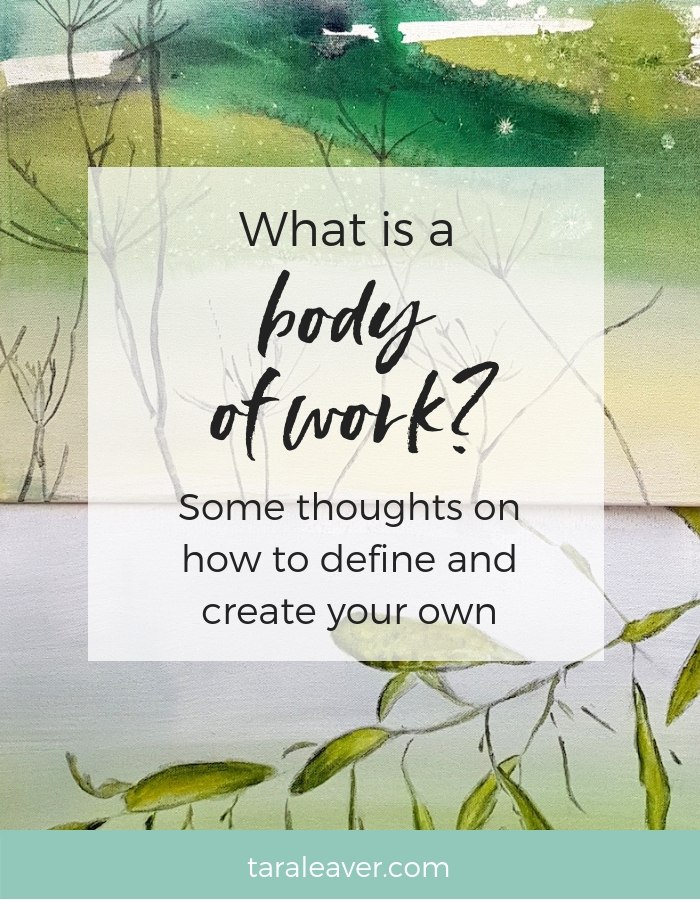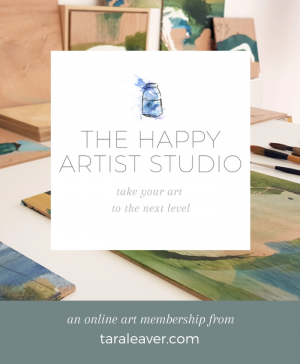
I’ve always thought of a body of work as being first and foremost the collective works of an artist in their entirety.
Recently however, I’ve also been talking about building a body of work, meaning a cohesive collection of true-to-me art in service to developing the artist side of my art career {as opposed to the teaching side}. Mine seems to be quite a flexible definition!
When I think about the phrase ‘body of work’, two things spring immediately to mind.
One is the word ‘oeuvre’, which comes from the French and translates literally as ‘work’, and is defined in the Oxford dictionary as ‘The body of work of a painter, composer, or author’.
The other is Picasso. I get a strong visual of all the different kinds of art he made – the Cubist paintings, the sculptures, the simplified drawings, his Blue Period, Guernica, and Les Desmoiselles d’Avignon, to name but a few.
He never bothered himself with fears about being inconsistent:
“The different styles I have been using in my art must not be seen as an evolution, or as steps towards an unknown ideal of painting. Everything I have ever made was made for the present and with the hope that it would always remain in the present.”
Picasso
So mostly, I think of a body of work as ALL of it, not just a single series or collection.
I hopped on Instagram to ask people what the phrase means to them, {thank you to everyone who responded!}, and, similar to my own conclusions, it seems to fall into two definitions, which often coincide or are connected.
- The sum total of everything you create as an artist
- A cohesive series or collection
So perhaps I’m not way off in my interpretations. 🙂
Gina Axlund echoed my thoughts:
“For me, ‘body of work’ doesn’t mean cohesiveness. Many artists had a huge body of work that span between different styles and mediums. Body of work for me is the sum of all the works I have produced that I recognize as ready, have signed and feel I can stand for. They may be in different mediums and themes. Series can be part of an artist’s body of work.”
I liked her point about her body of work containing work that she felt able to stand behind. Who says we can’t curate our own bodies of work?
Shilpa Agashe made an interesting comment about how we might create a body of work:
“Right now to me it means VOLUME. I figure I need to make as regularly as I can and when I do that I can see common threads emerging. It feels counter intuitive to restrict myself to certain parameters in order to get a consistent body of work, I would rather keep making and allow those parameters to emerge organically.”
I’m fully on board with this ‘try everything and lots of it’ approach. I think there’s a danger of feeling stuck or limited by what you’ve chosen, {or felt forced to choose}, if you’re trying to be consistent too soon.
It can take time and a huge amount of experimenting to reveal and develop what’s truest to you about your art.
Early work is often by definition lacking in the nuances and maturity of the work that emerges after a long period of exploration and digging deep into yourself and your art.
And of course it’s a spiral, not a linear journey. We learn and relearn as we grow.
Feelings about creating a body of work
I also asked people how the thought of creating a body of work made them feel.
Answers ranged from resistant to the repetition implied in creating a series, through overwhelmed and daunted, to excited. I suspect that how you feel about it depends very much on how you’re defining it and what you’re making that definition mean for you as an artist.
If you’ve defined the term for yourself as a tidy cohesive collection of similar work, and you’re either a relative newbie to making art {ie. in the ‘try everything’ phase} or find it difficult to stick to one thing {welcome to being creative!}, chances are the thought of developing a body of work is going to feel like a rather onerous mountain to climb.
If on the other hand you’re able to hold the definition loosely as all the work you’ll ever create, now you’re free to make your art knowing that all of it is contributing to your oeuvre!
And as Gina’s comment suggested, you can always ‘curate out’ whatever you don’t want included in your posthumous retrospective. 😉
A very comprehensive response came from Hannah Braime, of self development website Becoming Who You Are. I love that she moved the conversation beyond the confines of visual art – of course any creative work can become a body of work.
“My thoughts about this aren’t just about art, but about any creative pursuit. I think building a body of work is *the* most important thing, both from a growth and mastery perspective and, if you’re creating a business, from an portfolio/income streams perspective.
To me, it means viewing each individual piece of work like the piece of a jigsaw: as well as standing alone, the different aspects of a body of work also fit together to create a big picture of your growth and trajectory as an artist (or writer/creative/whatever you’re doing). The more you create through deliberate practice, the better you’ll become at what you do, and the more you will develop your own personal style (the way you do what you do that makes it yours).
Focusing on creating a body of work also takes the pressure off individual pieces to be “the one” – the painting that defines us as an artist, the sell-out that makes or breaks our livelihood, and so on. It takes the pressure off the outcome and frees us up to focus on the process. Building a body of work is my no.1 priority in my work life and approaching my career in this way has been super helpful.”
So many helpful observations there.
At this point I’ve come to the following definition as my personal understanding of what a body of work is:
A body of work is both a demonstration of your creative output, and the way in which you reach mastery of it.
By that token, my body of work is both the accumulation of everything I’ve made over the course of my life in service to my art, and it’s the path by which I’ve learned to create the art that feels most true to me.
It spans back to my school and art college days, when the figure was my passion, right through still life, landscape, portraiture and pure abstract, including other disciplines I’ve worked in, like sculpture and photography, to my current work, which could be described as contemporary or abstract landscape.
The point is, I have not always made the same style of work, nor have I always painted the same subject or used the same material, but every piece I’ve created has a single connecting factor – me – and that makes it all my own body of work.
What do you think? Do either or both of these ideas about what a body of work is resonate for you? Let’s continue the discussion in the comments!
 If creating a body of work is something you’re ready to get started on, I offer a range of courses to support you in that, and you can now access them in a lovely bundle inside the Happy Artist Studio!
If creating a body of work is something you’re ready to get started on, I offer a range of courses to support you in that, and you can now access them in a lovely bundle inside the Happy Artist Studio!
I recommend Abstractify and Touchstone for putting down strong roots in this area.







I loved this discussion… you really helped me understand that the whole or years of our work is our journey of self expression. I have always painted or created what has inspired me in that moment….. and I guess that we as artists should always be true to ourselves and what pleases us.
So pleased it was helpful to you Tina!
I consider “my” body of work to be everything I have ever created, in my artistic life.
Within that collection of work, I consider ” a” body of work, to be those works which link together some in way, works with a common thread or which stand together as a recognisable series or collection.
I have recently, been listening to an Australian podcast, Talking with Painters, and I am so relieved to hear so many well known and exhibited, major prize winning painters and Artists say that they they might explore a theme and media for a show and move on to something very different for the next show. Most actually reference the idea that the expectation that they should continue to make the same works would drive them crazy and that the whole idea of being a creative is to explore ideas and create new and fresh work.
This podcast gives me hope! I want to create series or collections of work, lots of them, different and exciting and fresh which will all still be part of my body of work!
Nice clear distinction Tracey! Haven’t heard of that podcast – must check it out, thank you for the reco! Interesting what you’ve heard – I do have a suspicion that even ‘completely different’ will always have that recognisable thread of the artist’s hand in it…